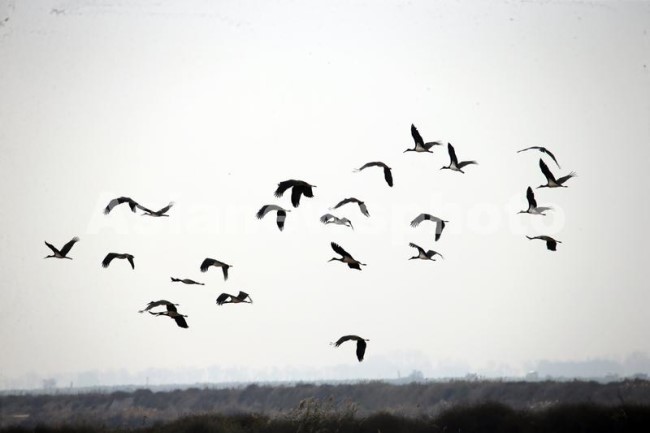GPS trackers aid rare bird conservation efforts

The black stork is a Class A protected animal in China, and its numbers are growing. [Photo by Li Shiju for China Daily]
LANZHOU -- For the first time, Global Positioning System (GPS) trackers have been used by the Heihe Wetland National Nature Reserve in Zhangye city, Gansu province, to monitor the trajectory of black storks.
Two black stork chicks have been fitted with GPS trackers that can generate real-time images showing the birds' locations, and the staff at the reserve can check them anytime by cellphone, said Shan Guofeng, an official with the administration of the nature reserve.
"We are attempting to figure out the normal breeding and migration patterns of black storks in order to obtain more information for protecting their population," Shan said.
Since their installation on July 9, the GPS trackers have been functioning smoothly, and the transmitted data indicate that both birds are doing well, with their range of activities expanding, Shan noted.
The Heihe Wetland National Nature Reserve in Northwest China, covering an area of about 41,000 hectares, is an important breeding ground, habitat and stopover place for wild birds.
According to the latest statistics, 218 species of birds, including many rare ones, have been spotted in the reserve, up from 155 in the 1990s. The increase in the numbers is attributable to strengthened ecological restoration efforts.
During a bird survey conducted in the reserve last year, a total of 627 black storks, a species under first-class state protection, were sighted, a number rarely seen for a single observation of black storks in China.
In recent years, the reserve's administration has initiated monitoring and study efforts involving black storks to gain more first-hand knowledge about the rare species.
Shan and his colleagues conduct daily monitoring during the birds' breeding and migratory seasons. As adult black storks are extremely vigilant, researchers can only observe their nests from a distance of approximately 60 meters using binoculars and other equipment. To ensure nothing is missed, cameras have been installed at four nests.
Before attaching the trackers, the researchers also measured the height and weight of the two baby birds. The measurement, taken while the parent bird was away from the nest, is for ensuring free and safe movement of the birds while wearing the tracker, which weighs around 40 grams, or about one percent of a young bird's weight.
"The parent bird will go out foraging at 6 am and fly back in two to three hours, so we had to hurry," Shan said.
With GPS devices, cameras and manual monitoring, the reserve has obtained a large quantity of data and established a partnership with relevant research institutes to jointly study black storks.
"I enjoyed my time with these black storks, and hope we can better protect them through systematic research," Shan said.








